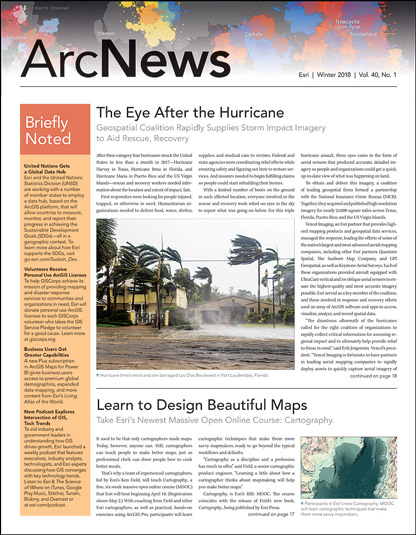Over the next decade, geography and GIS will move to center stage in society as most large-scale private and governmental organizations adopt mobile, real-time, and interactive geographic technologies and systems as core operations management tools. Consider the following trends:
- According to the Occupational Information Network (O*NET), professions such as geoscientist and geospatial information scientist and technologist are considered to have a Bright Outlook, meaning that they are expected to expand over the next decade.
- Geographers, geoscientists, cartographers, urban and regional planners, and other geographic professionals are expected to see average to much-faster-than-average job growth, with projected needs of at least 10,000–15,000 additional employees in each of these fields through 2026.
- Geospatial technology is considered a high-growth industry. Between 2017 and 2023, the market is expected to grow at an annual rate of 9.6 percent.
Jobs in geography and GIS are booming. And employers are clamoring to find well-trained and educated employees in nearly every sector of the economy.
What Employers Seek
Although written and oral communication skills are valued in all types of workplaces—as are research, finance, and budgeting expertise—geographers and GIS specialists possess a multitude of additional abilities valued by employers across a wide range of careers. Some of these unique skills and perspectives are
- Spatial thinking.
- A sense of how complex interactions are between humans and the environment.
- Competence in GIScience, cartography, and visualization.
- Experience in field research and analysis.
- An interdisciplinary approach to projects.
- Sensitivity to the distinctiveness of place.
- A global frame of mind.
Geographers and GIS specialists are well prepared to meet the rapidly evolving demands of today’s industries given their big-picture perspective, eye for detail, and ability to integrate and synthesize information at a variety of scales.
Finding a Job
The American Association of Geographers’ (AAG) Jobs in Geography Center website is an excellent starting point for job seekers. There, they will find openings for geography and GIS positions in a variety of industries spanning the academic, public, private, and nonprofit worlds. Job postings are searchable by sector, location, and topical specialty, and new postings are constantly being added. Other leading industry resources for finding jobs in geospatial technology and GIS include the Esri Careers website, GISLounge.com, GISjobs.com, GIS GIG, and the GIS Jobs Clearinghouse.
Students at all levels will also be interested in AAG’s new Student Opportunities Site (SOS), a free resource featuring a wide variety of graduate assistantships, internships, and postdoctoral research positions in geography and related disciplines. Young people interested in geography, GIS, and GIScience will find no shortage of opportunities, as new positions are added regularly. The SOS is also a great resource for professional development opportunities for those who are already employed, as there are often postings for professionals looking to advance their careers and education in geography and GIS.
Students and job seekers who are interested in learning more about the job market for geographers should also consider attending the AAG Annual Meeting, which will be held in New Orleans, Louisiana, April 10–14. The Jobs & Careers Center will feature drop-in career mentoring services plus dozens of panel sessions and workshops that provide hands-on opportunities to learn about and apply various ideas and get advice from experts in their fields. Attendees can also go to the center to browse dozens of job postings and student opportunities at their leisure.
Building a Career

The AAG’s Jobs & Careers website offers a broad selection of resources for current and aspiring geography and GIS professionals. The website features profiles of professional geographers; pages with salary data and trends that contain information about earnings, projected growth, demand for key skills, and job titles for more than 90 geography-related occupations; and the Ask a Geographer page, which includes contact information for experts from a variety of subfields who will answer questions about geographic issues and topics.
As part of its long-term commitment to enhancing diversity in geography and the GIS field, the AAG will also be working with the Congressional Black Caucus Foundation to recruit high school and community college students from underserved communities to attend the AAG Annual Meeting. This initiative is part of AAG’s Emerging Workforce Scholars program, which brought students from underserved areas in Boston to the 2017 AAG Annual Meeting.
We hope that many students and job seekers will take advantage of the sessions, activities, and events happening around the Jobs & Careers Center in New Orleans this spring. Our ultimate goal is that top-notch talent continues to find jobs—and eventually careers—in geography and GIS as these fields become even more central to people’s daily lives.
Doug Richardson and Mark Revell from the American Association of Geographers coauthored this column. Contact Richardson at drichardson@aag.org.


